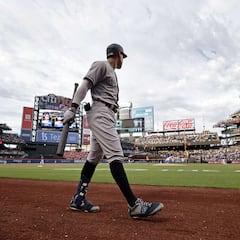What is baseball’s competitive balance tax and how will it affect the 2022 MLB trade deadline?
With the trade deadline only days away, the moves available to several baseball teams will be dictated in no small part by MLB’s competitive balance tax


Salary caps are nothing new, nor are they unique to baseball. The way that the cap operates may be varied, in the same way that the NFL uses a hard cap, while both the NBA and MLB go for a soft one, but the concept is the same. To create parity between teams, a more competitive league, and preventing spiralling costs that will ultimately kill a league off, everyone pretty much agrees that caps are a good thing in American sports. Oh, you may want to tweak it here and there, but very few voices are calling for its abolishment.
Most fans can live their lives blissfully unaware of the salary cap, but come trade deadlines and suddenly they are the top consideration.
As the MLB trade deadline fast approaches, there are six teams who will be working within the constraints of that financial boogeyman, in baseball known as the Competitive Balance Tax.
How can you not be romantic about baseball? pic.twitter.com/oekN8KBNd9
— Los Angeles Dodgers (@Dodgers) July 20, 2022
In place since 2003, the CBT currently sets a threshold of $230 million, with any money spent above that level taxed at a progressive rate, depending on how many seasons they remain above that amount. This season the Dodgers, Yankees, Mets, Phillies, and Red Sox are already over $230 million, with the Padres dangerously close.
The threshold provides provision for not only a financial tax, set at 20%, 30%, and 50% for the first, second, and third year that you surpass the $230 million mark, but also rising with several further thresholds in place. The penalties for exceeding $250 million are 32%, 42%, and 62% while $270 million earns you a tax of 62.5%, 75%, and 95%. The top tier is $290 million spend which will get you a tax of 80%, 90%, and 110%. Beyond this there are further penalties for hitting the $270 million and $290 million bands by dropping your first-round draft pick by 10 places.
Steve Cohen's bid to buy the Mets has been approved by MLB's Ownership Committee, per @soshnick.
— Kendall Baker (@kendallbaker) October 21, 2020
Cohen's net worth ($14.6B) makes him wealthier than the next three richest MLB owners combined. In a league with no salary cap, that's significant.https://t.co/HprflYLkyI pic.twitter.com/8XeVChnn6j
The Mets are just $100k below the top tier, so you could argue that most of the damage has already been done. But the difference in a 62.5% tax and an 80% tax will be something that they would like to avoid if possible. That top level of taxation is informally known around the league as the Cohen tax, named for the owner of the Mets, and that should give you an idea of just how much he will be dissuaded by any penalties. Hint: not much at all.
The Dodgers seem to live in tax purgatory of recent years, and like their east coast counterparts, they seem to be willing to simply pay whatever tax is demanded of them. Just a shade under the $270 million threshold, they will see any big signing as a step on the way to the World Series, and any penalties incurred will long be forgotten come October.
MLB trade rumors: Cardinals' Juan Soto talks intensify; Dodgers interested in Marlins All-Star https://t.co/k1okmEo2pc
— CBS Sports MLB (@CBSSportsMLB) July 27, 2022
The Yankees are a team that almost permanently inhabits that neverland beyond the tax threshold, yet due to some extremely clever bookkeeping and strong negotiation abilities, they were able to get the Cubs and Rangers to eat the salaries for Anthony Rizzo and Joey Gallo, dropping them below the threshold and resetting them for this season as first time offenders. Historically, the Yankees tend to ignore the first two, purely financial thresholds, and focus on staying beneath the $270 million level so as to keep their draft picks in place. On a run which sees them with the best record in baseball, and Aaron Judge having a record-setting year, they just might be willing to forego those draft penalties and shoot the works this year.
Boston are in a bind because although they are above the lowest tax threshold, they are having a stinker of a season. They could cut their losses and sell some of their big-ticket players, an option that Red Sox Chief Baseball Officer Chaim Bloom explicitly ruled out in recent days, or they could go all-in and ignore the cash implications by buying their way out of trouble. Conventional wisdom seems to indicate that this second option is the road they will be likely to take.
The Phillies pursuing a trade for Ian Happ just makes too much sense.@AlexCarrMLB explains what it could take to free the utilityman from the Cubs and how he could fit in with Philadelphia:https://t.co/UBuKjHc2p5
— Inside the Phillies (@PhilliesSI) July 26, 2022
The Phillies are not normally a team that you think of as a big spender, but this season they have dipped their toes over the line and it might end up paying off for them. With the wild-card spot frustratingly within reach, they could see the longest postseason drought in the National League come to an end, repaying any tax paid ten-fold. This is no time for them to get squeamish, in for a penny, in for a pound. Now that they have the playoffs in their grasp, they should ignore any tax threshold and just go all out for whichever players that they need.
The Padres dipped into tax trouble in 2021 and managed to cut back just enough to stay under the threshold for this season. But they can spit over the line, at just $1 million breathing room, so any late injuries or call-ups could push them into a second-time offender status, and for no real benefit. The more likely scenario is that they will suck up the loss and buy big at the deadline, paying whatever price they need to in search of a playoff spot.
Very interesting possible trade partner
— TheVIPRMartialArtist (@ViprThereal) July 28, 2022
Red Sox emerging as potential trade partner for Padres https://t.co/HVel9TK4HJ
Related stories
There are quite a few teams with no CBT worries coming into the trade deadline, perhaps the most intriguing of which are the Braves and Astros, who are both $20 and $30 million below the threshold. But the teams getting the most bang for their buck seem to be the Mariners, who are in second place in the AL West despite a payroll of only $137.7 million, the Brewers whose $154.6 million is enough to see them topping the NL Central, and the Guardians who are only 1.5 games adrift in the AL Central for the bargain price of $93.2 million.
The six at the top could perhaps glean a thing or two from these clubs.

